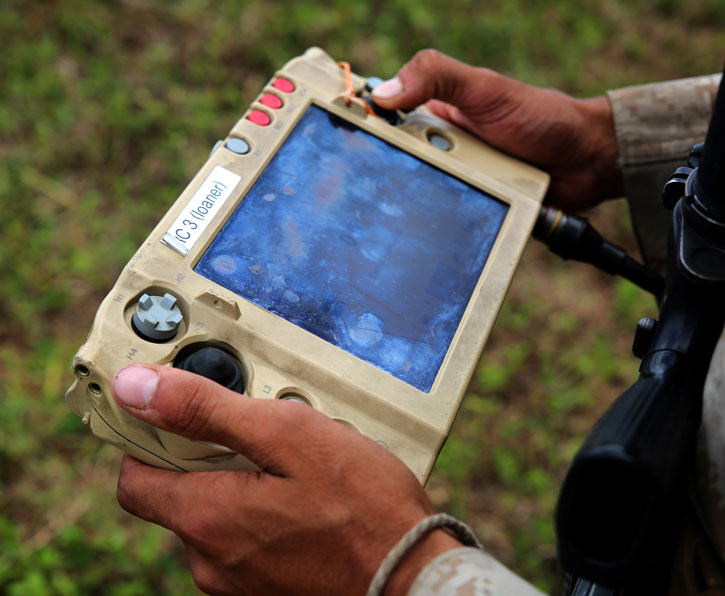
One of the robots included the Legged Squad Support System (LS3) which joined a Marine company on rugged terrain, offloading part of their supplies. The other was the Ground Unmanned Support System (GUSS), an autonomous Jeep size vehicle, that could deliver relatively heavy loads to the forward units, without putting drivers and security teams at risk. Both vehicles are part of MCWL’s thrust to lighten the load carried by the Marine squad; the two vehicles are designed to carry out such mission in different terrain. In addition, the GUSS can also be operated for casualty evacuation missions.
LS3 and GUSS robotic vehicles are both part of MCWL’s thrust to lighten the load carried by the Marine squad
The robotic mule, capable of traversing rugged terrain with Marines while carrying much of their load. It is programmed to follow an operator and detect large terrain objects to maneuver around. LS3, developed by Google’s Boston Dynamics The LS3 has recently reached a level of maturity that enabled the developmental system to operate with the troops. It has taken five years in concept developed by Boston Dynamics to create. The mule-like legged robot deployed to the Kahuku Training Area, participating with a combat unit on a realistic combat exercise for the first time, operating under the direct control of five young Marines from India Company, 3rd Battalion, 3rd Marine Regiment.

Lance Cpl. Brandon Dieckmann, a native of Las Vegas, remembers watching clips of the LS3 on Youtube before he joined the infantry. He said he never would have guessed he would be chosen to operate the machine, which has been affectionately nicknamed “Cujo” by his company. The Marines used “Cujo” to conduct resupply missions to the various platoons around the training area. The LS3 brought water to service members in terrain difficult to reach by all-terrain vehicles.
“I was surprised how well it works,” Dieckmann said. “I thought it was going to be stumbling around and lose its footing, but it’s actually proven to be pretty reliable and pretty rugged. It has a bit of a problem negotiating obliques and contours of hills.”
The LS3 is being used as a logistical tool during RIMPAC as opposed to a tactical tool, due to its loud noise during movement and problems traversing certain terrains. “I’d say 70 to 80 percent of the terrain we go through, it can go through,” Dieckmann said. “There are times when it is going to fall over, but most of the time it can self-right and get back up on its own. Even if it doesn’t, it can take one person to roll it back over. The way it is designed is that you can easily roll it back over.”
However, the robotic mule is still in development. Dieckmann said creating more space within the LS3 for equipment, like heavy weapons systems, would be beneficial for quicker movement in a field or combat environment.
Some of the Marines have grown attached to Cujo. In particular, Pfc. Huberth Duarte, an infantryman with India Co., 3/3, and an operator for the LS3, says the robotic mule has become like a dog to him. He also mentioned the controls are simple to learn and have joy sticks. He said it “feels like playing Call of Duty.”
Putting the LS3 in the hands of young Marines is vital to the development of the program, said Ben Spies, a contractor with Boston Dynamics observing the AWE. “This is the first time we put the LS3 in a training environment like this. They push it to the max. It helps us develop it more, because right now, only the engineers have it.”


The LS3 can get them into terrain they can’t resupply themselves with traditional equipment. Another vehicle supporting the logistic resupply is the GUSS, access with conventional vehicles. Another robot tested by the MCWL was the Ground Unmanned Support System (GUSS), an ITV fielded with the corps, we have taken this standard ITV vehicle and outfitted it with autonomous systems, enabling it to operated either remotely via backpackable remote control system, or given waypoints, enabling the vehicle to traverse terrain on its own, avoiding obstacles, and get to the point it was sent to. The GUSS was loaded with resupply gear, water, food or ammunition, the Marines will still provide support for the vehicle, but will not have to drive it or be located close to it to conduct the resupply mission. The escort force will be able to secure the GUSS while moving on safer areas, while the vehicle moves on road.
The GUSS was equipped with an autonomous kit developed by TORC, and controlled through the Tactical Robotic Controller (TRC), a kind of ‘universal controller’ for robotic systems. It allows the Marines to control the GUSS, LS3 as well as the Raven UAS. The use of a common gear reduces the amount of training needed to develop the necessary skills, and reduce the load carried by the troops. The TRC will also be coupled with communications and computing gear to transfer video and data through tactical networks.






















